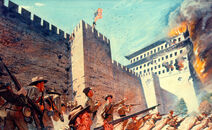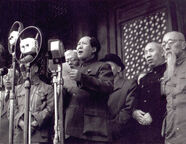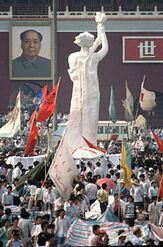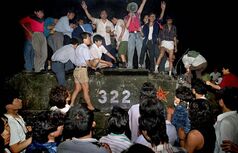| |||||
| Country | |||||
| Established | 1045 BCE (Zhou Dynasty) | ||||
| Area | 16,411 km² | ||||
| Population | 21,707,000 | ||||
Beijing (Peking) is the capital of the Chinese Federated Union. It served for some time in the past as the capital of various ancient Chinese dynasties, the Republic of China, and the People's Republic of China. The city is home to various landmarks such as the Forbidden City, Tiananmen Square, the Temple of Heaven, and various government buildings belonging to the former Chinese Communist Party.
History[]
Pre-War[]

A painting depicting US soldiers scaling the Great Wall during the Siege of Peking in the Boxer Rebellion.
Beijing was the capital of several ancient Chinese dynasties up until the Qing Dynasty. In 1900, the Boxer Rebellion broke out in the city, with anti-colonial and anti-Christian scholars called "Boxers" rose up against the Western colonial powers. The rebellion was crushed and China was forced to make concessions for the foreign powers. The city would then become the capital of the Republic of China in 1912.
From the 1920s to the 1930s, China would be in a state of civil war, fought between the Nationalist Kuomintang (KMT), the Chinese Communist Party, and various warlords fighting for control. The civil war was only interrupted when Japan invade Manchuria in 1937, starting the Second Sino-Japanese War - which would then be a part of the Pacific Theatre in World War II. The civil war resumed in 1946 after the defeat of the Japanese Empire on the favor of the communists.

The establishment of the PRC by Mao Zedong on October 1, 1949.
On October 1, 1949, the People's Republic of China was established by Chairman Mao Zedong in the Forbidden City with its capital in Beijing. In May 1950, the communists expelled the last KMT holdout in Hainan Island, resulting in Chiang Kai-Shek's forces retreating to the island of Taiwan.China would then experience turbulent periods from 1950s to the 1960s, namely the Great Leap Forward and the Cultural Revolution. In 1969, China and the Soviet Union held a brief border conflict in the Ussuri River over Zhenbao Island. The early 1970s was the period in which China reopened relations with the West, particularly the United States. President Richard Nixon became the first president to visit China where he met with Mao Zedong in Beijing. Up towards the 1980s, the United States and China cooperated to contain the Soviet Union. Ronald Reagan visited Beijing in April 1984; George H.W. Bush visited the Chinese capital in February 1989.

Goddess of Democracy Statue erected in front of Mao's portrait in Tiananmen Square during the protests of 1989.
The city was the site of the Tiananmen Square Protests that started in April 15, 1989 where students have gathered after the death of Hu Yaobang, a liberal reformer who was deposed after losing a power struggle with hardliners over the direction of political and economic reforms. The following weeks to come, more and more students backed by citizens began protesting for more transparency. Former CPC General Secretary Zhao Ziyang made an appearance in the square to ask for a compromise from the students. Premier Li Peng declared martial law around Beijing on May 20, 1989. On the dawn of June 4, 1989, the People's Liberation Army brutally suppresses the student protests in the square. The following day, the military had complete control over the square. International news reports showed footage of lines of tanks, armored vehicles, and soldiers around the square. The iconic "Tank Man" photo was also taken and leaked to international stations, which would serve as a symbol of defiance against the Communist Party.
World War III and the Second Chinese Civil War[]
The hardline leadership of the Communist Party later declared war on the West in a speech made in front of the National People's Congress in the Great Hall of the People. The citizens were told war was necessary to "promote core socialism values worldwide." The citizens were also told that war was winnable against the capitalist forces. The People's Liberation Army then launched attacks on Hong Kong, Macau, Taiwan, India, South Korea, Burma, Nepal, Japan, the Philippines, Guam and the Northern Mariana Islands; with the latter the first blue navy operation conducted by the PLAN. The PLA also attempted to send reinforcements to Soviet forces in North America, but were intercepted by the US Pacific Fleet - coupled by the fact that the Soviets were expelled in these areas. In Japan, the Chinese only got as far as Hokkaido (with Soviet backing) and were driven off in Okinawa. In the Philippines, the Chinese invasion clearly failed after both the Filipinos and the Americans fought hard that casualties mounted. Additionally, ships of the People's Liberation Army were sunk on a daily basis by submarines from the US, UK, Australia, New Zealand, Taiwan and Japan that were silently sneaking up the Chinese coastline.

Residents celebrate the Fall of Beijing.
Because of these losses, the West decided to use this as propaganda to incite anger amongst the Chinese people. There was also clandestine aid to separatists in Xinjiang and Tibet; and to whatever resistance in Hong Kong and Macau. Soon, the cities of China were under mass unrest. The PLA soon lost control of the situation as majority of the soldiers defected to the rebels; they were joined from other soldiers who were recently released as POWs from other countries. The Second Chinese Civil War began. The rebels troops first released former General Secretary Zhao Ziyang from house arrest. Zhao had been fired from his post during the Tiananmen Square protests for openly hearing the student's protests. After his arrest, Premier Li Peng ousted Deng Xiaoping from the CMC and ordered the crackdown on the student protestors. The rebels subsequently elected Zhao as the first president of the new democratic China. One-by-one, major cities in China fell to rebel control. Beijing was then under siege. Fierce street and house-to-house fighting followed. By the second week of September 1990, the CPC leaders prepared to escape Beijing to a secret leadership bunker in the Kunlun Mountains - which was built to withstand a nuclear war with both the Soviets and the Americans. However, the escape was botched as the rebels captured the Zhongnanhai. Li Peng and the other hardliners were captured by rebel forces and made into prisoners of war.
Post War[]
As Beijing fell to the rebels, an interim administration was placed with Zhao Ziyang as the leader. One of his first act was to declare a temporary martial law in order for the country to stabilize. Both sides were urged to lay down their arms. The weeks to come, Zhao met with the Dalai Llama of Tibet, the governor of East Turkestan, and President Lee Teng-Hui of Taiwan in the Great Hall of the People to discuss negotiations on how the new China will recognize these states. Zhao recognized these three states as sovereign nations on October 1, 1991, with much shock and praise around the world. This occurred just two months after the formation of the Chinese Federated Union.
From the 1990s-2000s, Beijing's former glory was restored. The city was is one of the megacities of the world and in China, along with Hong Kong and Shanghai. Western investment helped in the globalization of Beijing.
Landmarks[]
The following gallery shows Beijing's famous landmarks, of which many have been restored of its former glory from the turbulent times of the Cultural Revolution and World War III:
| ||||||||||||||||





